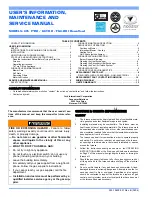
33
INSTALLATION CONSIDERATIONS
8.
Low Flame Sense Signal.
If the furnace continues to
operate and the micro-amp signal from the flame sensor
falls below specified level, the diagnostic light code for
this problem will be
seven flashes
followed by a pause.
The probable cause is either a coated/oxidized sensor,
incorrectly positioned sensor in burner flame or lazy burn-
er flame due to improper gas pressure or combustion air.
9.
Igniter circuit or poor ground.
Improperly connected
igniter, bad igniter or poor ground to the equipment. The
diagnostic light code for this problem is
eight flashes
.
Combustion Quality
Combustion quality can be affected by several factors. Major
factors are venting and draining.
Venting
The venting system should be planned and installed with the
following in mind;
•
Should not be longer than necessary
•
Use 45°elbows rather than 90° elbows when possible
•
Must not sag or otherwise trap condensate
•
Use longest radius fittings possible
•
If using 3" venting, make the transition from 2" to 3" as
close as practically possible
•
Make sure there is no flue gas recirculation into the
combustion air pipe
Condensate Drainage
Furnace combustion can be affected if a furnace is holding
condensate. Check for proper connections of drain hoses,
make sure furnace condensate trap is clean. Make sure
furnace is not improperly sloped. Make sure air conditioning
coil drain is not interfering with furnace drain.
Other Causes
1. Manifold Gas Pressure must be set for the gas being
used, Natural or L.P., high and low firing rates. If converted
to L.P. gas, check size of all orifices
2. Remove Draft Inducer, Check the integrity of the gasket
between the inducer and the collector box cover, any
air leak here will have a negative effect on combustion.
Check the orifice hole in the collector box, it must be free
of burrs on both sides
3. Make sure burners are clean, not out of position and line
up correctly with exchanger tubes, including the heat
exchanger orifice plate between the burners and the
heat exchanger tubes, make sure it is not loose, missing
a screw or hanging down between the burners and heat
exchangers causing flame impingement.
4. Make sure the field installed gas line is not binding and
causing distortion of burner assembly
5. If the furnace is installed as a one pipe system; make
sure the surrounding area and structure are adequate
to provide combustion air
6. Make sure there are no cabinet air leaks allowing sup-
ply air to affect combustion
7. If heat exchanger integrity is uncertain, follow proce-
dures in Service Bulletin SF-041
t
winning
T
O PREVENT UNRELIABLE OPERATION OR EQUIPMENT DAMAGE, THE
GAS MANIFOLD PRESSURE MUST BE AS SPECIFIED ON THE UNIT
RATING PLATE.
O
NLY MINOR ADJUSTMENTS SHOULD BE MADE BY
ADJUSTING THE GAS VALVE PRESSURE REGULATOR.
CAUTION
WARNING
P
OSSIBLE PROPERTY DAMAGE, PERSONAL INJURY OR DEATH MAY OCCUR IF
THE CORRECT CONVERSION KITS ARE NOT INSTALLED.
T
HE APPROPRIATE KITS
MUST BE APPLIED TO INSURE SAFE AND PROPER FURNACE OPERATION.
A
LL
CONVERSIONS MUST BE PERFORMED BY A QUALIFIED INSTALLER OR SERVICE
AGENCY.
Furnaces may be twinned without the use of a twinning
kit. Furnaces must be the same model and equipped with
PCBBF145 control boards. Follow the diagram provided
i this manual. Connection of the "twin" terminals of each
control together will allow simultaneous operation of two or
more furnace indoor blowers to operate synchronously on a
common duct system. Field installed low voltage thermostat
wiring, 3/16" terminals are required to make this connection.
An isilating relay (24 VAC coil & N/O SPST) contacts is also
required if the furnaces are not fed from the same line voltage
phase. A pulsing DC signal is used to share the call for fan
operation between furnaces. The duration of the Pulse width
determines the speed that the reading control will energize
its blower motor.
















































